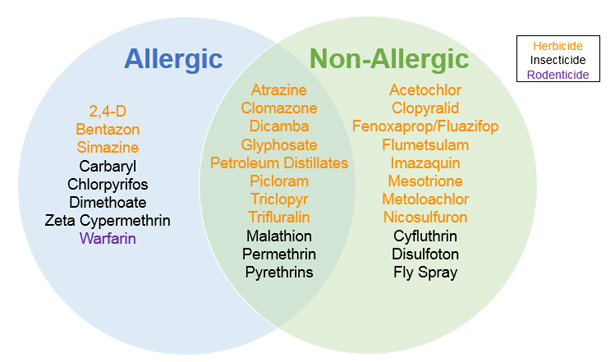11
Aug
78 Commonly Used Agricultural Pesticides Linked to Wheezing
(Beyond Pesticides, August 10, 2016) New research connects 78 pesticides commonly used by farmers with many adverse respiratory effects, including both allergic and non-allergic wheeze. The study, Pesticides Are Associated with Allergic and Non-Allergic Wheeze among Male Farmers, was led by NC State environmental epidemiologist, Jane Hoppin, ScD and colleagues from the National Institute of Environmental Health Sciences (NIEHS), the National Cancer Institute, Westat and the National Institute for Occupational Safety and Health (NIOSH). This is one of the most comprehensive evaluations of pesticides in relation to wheeze that has been evaluated to date, finding that several commonly used pesticides in both agriculture and residential settings can cause adverse respiratory effects.
 “Fifty-one of the pesticides we tested in this study had never been analyzed in terms of their effects on respiratory outcomes. And some of them, like glyphosate, 2,4-D and permethrin, aren’t just used on farms. They’re used residentially now to kill weeds or treat fleas on pets,” said Dr. Hoppin. “We believe it’s important information that will help people make decisions about pesticides.”
“Fifty-one of the pesticides we tested in this study had never been analyzed in terms of their effects on respiratory outcomes. And some of them, like glyphosate, 2,4-D and permethrin, aren’t just used on farms. They’re used residentially now to kill weeds or treat fleas on pets,” said Dr. Hoppin. “We believe it’s important information that will help people make decisions about pesticides.”
Researchers used interview data from the 2005-2010 Agricultural Health Study (AHS) to assess the correlation between pesticide exposure and wheeze in male farmers. 22,134 farmers were interviewed in the current study, answering questions regarding which pesticides they had used in the previous year, current farming activities, medical conditions, and other demographic factors. Using this information, researchers were able to compare the frequency of allergic or non-allergic wheeze in farmers who had never used the pesticides being evaluated, to those who had.
Included in the 78 pesticides evaluated are: 45 herbicides and plant growth regulators, 25 insecticides, six fungicides, one fumigant, and one rodenticide. Overall, 29 pesticides had some association with at least one type of wheeze; 19 were significantly associated with allergic wheeze and 21 were associated with non-allergic wheeze; 11 pesticides were significantly associated with both.
Of the pyrethroids evaluated, which are among the most commonly used insecticides, all but one (tefluthrin) are approved for residential uses, and the most frequent users of permethrin in the study were most likely to report wheeze, both allergic and nonallergic. Of the organophosphates, malathion, which is is widely used in mosquito control programs, was associated with both allergic and non-allergic wheeze.
Three of the most commonly used herbicides, glyphosate, 2,4-D, and atrazine all were associated with at least one of the wheeze outcomes. Glyphosate, the most commonly used herbicide in the world, as well as atrazine were associated significantly with both types of wheeze, while 2,4-D was primarily associated with allergic wheeze. Researchers noted that use of glyphosate, commonly sold under trade name RoundUp, produced and sold by Monsanto, has increased dramatically since their initial analysis due to the prevalence of genetically engineered crops that are glyphosate tolerant (“RoundUp Ready”). This increased frequency of use gave researchers more power to detect associations, with effect estimates similar to those reported previously. Initially touted by the industry as a “safer” pesticide, the mounting evidence of glyphosate’s hazards is piling up.
The study also acknowledges the possibility of synergistic effects that the pesticides may have, and evaluated whether correlation among the pesticides were responsible for the large number of significant findings. However, researchers found no strong evidence showing that when mixed, the chemicals had any significant changes in results.
While researchers point out that little is known about the potential impacts of currently used pesticides have on the respiratory system, there is mounting scientific evidence that link pesticide exposure to respiratory problems and asthma, especially in young children. Beyond Pesticides’ Asthma, Children and Pesticides webpage documents many of the studies that have found evidence that exposure to pesticides is correlated with asthma. In addition to being an underlying cause of the disease, pesticides can also trigger asthma attacks for those who already suffer from it. Furthermore, the Pesticide-Induced Diseases Database documents over 30 studies linking pesticides to asthma and other respiratory effects.
The study concludes that “while this analysis was limited to male farmers who, most likely, have applied pesticides for decades, the chemicals that they use are not exclusively agricultural. The findings for chemicals like glyphosate, 2,4-D, carbaryl, and the pyrethroids are particularly relevant for consumers who would like to minimize their wheeze and allergy risk associated with the use of chemicals in their homes, gardens and play areas.”
Fortunately, there are alternative ways to manage pests that do not rely on toxic pesticides. Ultimately, the widespread adoption of organic management is necessary to protect consumers and the environment in the long-term. Beyond Pesticides has long sought a broad-scale marketplace transition to organic practices that disallows the use of toxic synthetic pesticides by law and encourages a systems-based approach that is protective of health and the environment. This is why food labeled organic is an important choice. Around the home, simple mechanical fixes, like doorsweeps, caulking and sealing cracks and crevices, a well-fitted trash can lid, and diligent cleaning, can prevent pest infestations in the first place, and isolate and contain ongoing problems. For a step-by-step guide on how to control common indoor pest problems without pesticides, see Beyond Pesticides ManageSafe database.
Source: NC State News Press Release










